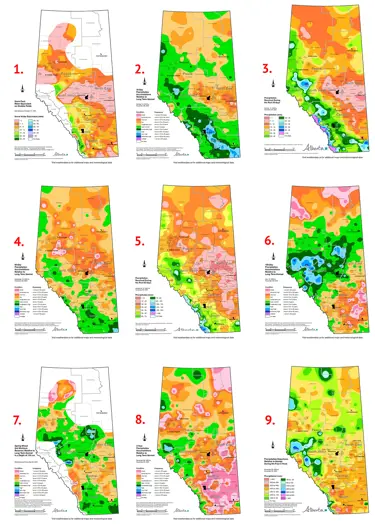Moisture Update - November 8, 2023

Synopsis
Map 1: This year winter threatened to come early, with many lands receiving their first major snowfall around October 21, 2023. By October 31, snow was still visible on the landscape across most of the province, lying between the Yellow Head Highway and the USA border and through parts of the Peace Region (Map 1). During the last days of October, a gradual warming trend emerged which is currently forecast to remain in place for at least the foreseeable future. This has allowed early snow packs to melt completely and in some areas it has helped to modestly improve soil moisture levels, particularly across the southern portions of the province.
Recent Precipitation Trends, as of November 8, 2023
Maps 2, 3, 4, & 5: Looking back over the past 30-days, most of the Southern and Central Regions have seen near normal precipitation for this time of year (Map 2), with a large area across southern Alberta and the western portions of the Central Region trending above normal. In sharp contrast, dry conditions have persisted throughout much of the North East, the east-half of the North West and the extreme northern parts of the Peace Region.
Total rainfall accumulations over the past 30-days, have exceeded 30 mm across parts of southern Alberta and along the Foothills, extending up as far as the Peace Region. The extreme southeast corner of the province has been relatively wet, with upwards of 40 mm being recorded at some stations. In sharp contrast, a large area across the eastern portions of the Central and Northwest Regions, along with much of the North East and northern Peace Region have received less than 10 mm (Map 3).
Total precipitation accumulations over the past 60-days, have generally been below normal across most areas, with the exception of the Southern Region which has tended to be near normal (Map 4). Please bear in mind that September and October tend to be relatively dry months usually. Notably, much of the east-half of the Central Region has remained dryer than normal, following a very dry growing season. Across much of the North East, North West and Peace Regions, it has been dry as well, with all areas having pockets of land with at least 25-year low accumulations over this time frame. Many of these areas have received less than 20 mm of moisture in the last 60-days (Map 5). Above average winter precipitation will be needed to build healthy snowpacks, in order to help replenish surface water supplies this coming spring.
Recent dry conditions across the North West Region, have been offset to some extent by above average precipitation received over the past 180-days (Map 6). However, large deficits are found across much of the Southern, Central and Peace Regions, with all having tracts of land in the less than once in 50-year low category.
Soil Moisture Reserves, as of November 8, 2023
Map 6: Soil moisture reserves heading into winter have rebounded to near normal across most of the Southern Region (Map 6), but again it is normally quite dry at this time of year, so total amounts of stored moisture for next year’s crop are still relatively low, even in these areas. Across most of the Central Region and much of the North East and Peace Regions, lands will be heading into winter with below normal soil moisture reserves. In contrast, despite dry fall weather across the North West Region, soil moisture levels remain near normal as a result of ample summer rains.
Perspective
Maps 7 & 8: Over all, most of Alberta’s agricultural areas have been running long term moisture deficits extending back over at least the last 3-years (Map 7). This has had an impact of the overall health of the landscape and is reflected in dwindling surface water supplies and poor growth in both native and planted perennial species. Most of the Southern, Central and parts of the North East Regions, are estimated to have a 3-year period, in aggregate, this dry less than once in 50-years (Map 8). This translates to total moisture deficits in at least the 300 to 400 mm range which in the case of the Special Areas and adjacent parts of the Southern Region, translates to a full year of lost moisture in the last 3-years. Many parts of Alberta are long due a wet cycle. Multiple years of below normal moisture regimes are taking their toll.
Contact Us
Saddle Hills
Junction of Hwy 49 & Secondary Hwy 725
RR1, Spirit River AB
T0H 3G0
T. 780-864-3760
Fax 780-864-3904
Toll-free 1-888-864-3760
frontdesk@saddlehills.ab.ca
Sign up to our Newsletter
Stay up to date on the Saddle Hills activities, events, programs and operations by subscribing to our eNewsletters.
